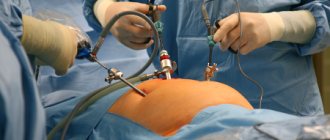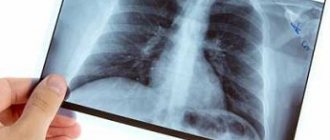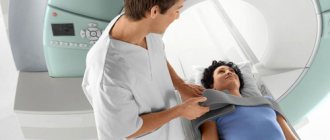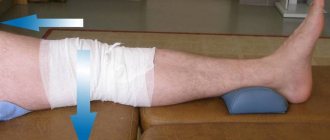In gynecology, a classic method for diagnosing cervical pathologies called colposcopy is often used. Such an examination is carried out on a chair using a special device - a binocular microscope with a directional light source.
During the examination, the physician objectively assesses the condition of the mucous membrane of the cervix and vagina. In order for the results to be extremely accurate, you need to carefully prepare for the procedure and follow all the doctor’s recommendations. Many patients are concerned about the question “Is it possible to have sex after colposcopy?” You will find the answer in this article.
Preparation for cervical colposcopy
Colposcopy of the cervix is a visual examination of this area, giving multiple magnification. For this, a special device is used, or a colposcope, which guarantees zooming up to 40 times.
In current gynecology, photo and video examination of the cervix is used with the possibility of further storing the information obtained. This makes tissue analysis before and after repair easier and faster. Colposcopy is indispensable if cervical erosion and other recurrent diseases are suspected.
Before the examination, you must abstain from vaginal sex for 48 hours and not use tampons for the same long time. It is recommended to take any over-the-counter pain reliever before starting the procedure. Let's say Ibuprofen or Paracetamol.
The date for the analysis should be chosen so that it does not fall during menstruation. A prerequisite for preparation is compliance with personal hygiene standards.
Progress of the process and possible sensations
Colposcopy is performed in a gynecological chair. The doctor inserts ordinary speculum into the vagina, performs a visual examination, and cleanses the walls of the mucous membrane. Afterwards, an examination is carried out using a colcoscope equipped with optics to increase visibility and a lighting system. In the case of video colposcopy, the device is equipped with a digital video camera, which transmits the image to the monitor.
The inspection process takes about a quarter of an hour, sometimes a little more. Since the speculum is located in the vagina throughout the entire period, the walls are periodically irrigated with saline solution.
Extended colposcopy may cause some discomfort. With this option, in addition to the standard examination, the woman’s mucous membrane is treated with a solution of vinegar and Lugol’s.
This manipulation is carried out for a more detailed study. The applied composition will color healthy tissues, while the affected areas will not be pigmented.
According to indications, a biopsy is performed - taking a couple of millimeters of tissue with a special instrument for further research. The moment is unpleasant, but one cannot say that it hurts. Colposcopy with biopsy allows you to find out the nature of pathological changes in the cervix and diagnose the disease at an early stage. If you have a high pain threshold or severe fear, you should consult a doctor with a request for local anesthesia at the time of collecting a sample of material.
After a colposcopic examination with a biopsy, a small wound appears at the site where the tissue sample was removed. This may cause short-term and minor bleeding. A woman is advised to use only a sanitary pad, not a tampon, and not have sexual intercourse until the mechanical damage has completely healed.
In case of heavy bleeding and pain, be sure to visit a doctor. Based on the results of colposcopy, therapy or additional examination and tests are prescribed. If the doctor does not make any prescriptions, it means that there are no abnormal changes in the cervix and vaginal walls.
The level of pain also depends on how carefully the procedure is performed.
What sensations may occur after colposcopy?
Colposcopy can be done in the manipulation room of a gynecologist. This is an outpatient procedure that does not require the woman to be hospitalized; after the procedure, she can leave the medical facility within a few hours. Carrying out colposcopy with taking a biopsy is accompanied by certain pain sensations (to reduce their severity, the gynecologist uses anesthetics).
After the procedure, for several hours (sometimes up to 24 hours), the woman may be bothered by nagging pain in the lower abdomen. There may also usually be light spotting for several days, indicating slight bleeding from the mucous membrane of the biopsy area. These manifestations usually go away on their own and do not require special treatment. The gynecologist must warn you about their possible development before the procedure.
What is the procedure
Colposcopy is a therapeutic and diagnostic procedure that allows a detailed assessment of the condition of the mucous membrane of the vaginal wall and the vaginal part of the uterine cervix. The procedure is performed in a gynecological chair using a colposcope - a device that is a large microscope on a tripod. The device is equipped with eyepieces of different optical powers, allowing for 40x magnification.
Using gynecological speculum, the doctor widens the entrance to the vagina and examines the mucous membrane through a colposcope. The device allows you to examine each area in great detail and, if necessary, carry out additional studies and procedures under vision control.
In the absence of gross pathological changes, he sees a uniformly colored pink mucosa. If any areas are in doubt, the surface is painted with special solutions (Lugol's solution, iodine). Healthy mucous membranes take on a more pink or brown tint, while pathological areas appear paler.
Lesions that cause suspicion to the doctor are subject to biopsy examination. This is done directly during the manipulation. Epithelial cells are collected using special forceps. Also, if necessary, laser coagulation of erosive foci can be performed.
Colposcopy is quite safe and painless and does not require special drug preparation or anesthesia. Only taking a biopsy and performing coagulation can be noticeable, so in these cases local anesthesia can be performed by irrigating the mucosa.
What can be detected with it?
Colposcopy with high accuracy makes it possible to detect diseases or pathologies such as:
- metaplasia of squamous epithelium, which is a normal process of erosion healing;
- dysplasia, which can cause cervical cancer;
- Chronic cervicitis is an inflammatory process of uterine tissue;
- flat condyloma, which is a viral infection of cells;
- cervical cancer;
- leukoplakia and all its forms, which are characterized by impaired maturation and keratinization of the epithelium.
Dependence of the quality of examination and treatment on the menstrual cycle
Like any diagnostic method based on subjective factors, the result of using endoscopic equipment to examine patients may depend on the physiological characteristics of the body.
What do experts recommend?
Many experts consider what day of menstruation a colposcopy is performed to be a fairly important factor in the quality of research.
Most doctors in this field are of the opinion that the optimal period for such a study can be considered the first half of the cycle. The most reliable results are usually obtained 3-5 days after the last menstruation, especially if the woman has carried out special preparation of the vaginal mucosa using suppositories with Betadine.
However, quite often there are situations when, for various reasons, such a study could not be carried out during this period of time. And yet, we often have to solve the problem of whether it is possible to do a colposcopy before menstruation.
Most gynecological clinics do not see much point in such a study. The thing is that before menstruation, the cervical canal is usually tightly clogged with a large amount of mucus. This is a purely physiological condition, but it can significantly distort the overall picture of the condition of the internal genital organs.
Contraindications for endoscopic examination
Colposcopy is one of the safest and most painless methods of instrumental examination of women. All possible restrictions are related solely to the patient’s menstrual cycle. To obtain reliable results, it is preferable not to prescribe such a study:
- During the period of egg maturation. The cervical canal of the cervix at this time is completely blocked by a large amount of mucus, which can distort the overall picture. Under the influence of sex hormones, the density and viscosity of mucus during ovulation increases significantly, which makes colposcopy an absolutely pointless exercise.
- It is not recommended to carry out such instrumental research at the height of menstrual bleeding . In addition to the fact that the presence of blood in the vagina will significantly reduce the likelihood of obtaining an adequate result, possible mechanical damage to the vaginal wall during manipulation can provoke inflammation.
- In addition, any inflammatory process in the area of the internal genital organs is in itself a contraindication to such a study. Provoked mucous membranes are always more susceptible to germs and bacteria.
To conduct an endoscopic examination, doctors usually recommend waiting 2 - 3 weeks after the end of treatment for inflammatory processes of the woman’s internal genital organs.
We recommend reading the article about pelvic ultrasound during menstruation. From it you will learn about the optimal time for the procedure, indications for ultrasound examination, as well as reasons when ultrasound cannot be postponed.
Restrictions after extended colposcopy
Since a routine examination of the mucous membrane of the vagina and cervix using a colposcope is a non-traumatic procedure, there are no special restrictions after it is performed. It is recommended to refrain from having sex for several hours, as it may be accompanied by some discomfort associated with the colposcopy.
Extended colposcopy is an examination of the vagina and cervix using a colposcope using special chemical reagents. They are applied to the mucous membrane in the area of visible changes to visualize the pathological process. In some diseases, the color of this reagent changes, which allows the doctor to make a conclusion about the presence of a corresponding pathology.
Sometimes such reagents, when applied to the mucous membrane, can lead to irritation, so it is recommended to refrain from having sex for 24 hours after an extended colposcopy. If a biopsy was performed at the same time, which leads to trauma to the mucous membrane, then after it it is not recommended to have sex for up to 7 days, and douching and visiting a bath or sauna are also excluded. A consultation with a gynecologist before and after the procedure will help you accurately clarify all the nuances of the restrictions.
Colposcopy is an informative method for diagnosing gynecological pathology, so its use has become widespread. Following restrictive recommendations will help prevent the development of possible complications after colposcopy.
Indications
Colposcopy is prescribed to patients after a preliminary examination in a gynecological chair. Indications for diagnostics are the doctor’s suspicions of the development of such pathologies:
- Erosion;
- Polyps and endometriosis;
- Leukoplakia;
- Oncological processes.
Also, during the examination, it is possible to identify inflamed areas of the mucous membrane, pathological changes in the structure of endometrial cells. It is noteworthy that directly during colposcopy, a physician can treat certain diseases, perform cauterization, or remove biomaterial for biopsy.
Colposcopy is the main method of treating erosion. If medications are not effective, the pathological areas are cauterized with a laser or directed electric current, and sometimes surgically removed.
Types of calposcopy
There are five types of this survey:
- survey;
- with color filters;
- extended;
- chromocolposcopy;
- colpomicroscopy.
In the first case, the cervix is examined under magnification without chemicals. The second method involves the use of light filters, most often green. It is this that makes it possible to thoroughly study the network of blood vessels in the uterine area.
With an extended type of calposcopy, chemical reagents are used, which, depending on application to a particular area of the internal genital organs, may indicate certain pathologies. Speaking about the last two methods, it should be noted that:
- Chromocolposcopy is one of the options for advanced diagnostics, which involves changing the color of the cervical epithelium with hematoxylin, eosin or methylene blue. The presented dyes perfectly identify cells, which makes it possible to determine the presence of dangerous foci at the cellular level;
- Colpomicroscopy is the study of previously stained parts of the cervical epithelium under significant magnification. It can range from 160 to 280 times. Experts note that this method is a combination of two methods: histology and cytology.
Undesirable consequences - are there any?
Many people are interested in the question of whether it is possible to do colposcopy and whether it will cause harm. Almost any woman, both healthy and with certain pathologies, can undergo this procedure, as it does not cause any side effects.
During it, some unpleasant sensations may occur, but this is not critical. To prevent this from happening, a woman should relax as much as possible.
But if a woman is allergic to iodine, the doctor must first find out this, otherwise the subsequent allergic reaction may be unpredictable. The vinegar used during the procedure may cause a burning sensation for the patient. But if her pain threshold is reduced, then most likely she won’t even feel it. In general, there are no negative processes after colposcopy.
Typically, women who have recently given birth are not prescribed a colposcopic examination. In the first two months after birth, the squamous epithelium is damaged and the vaginal mucosa is not fully restored, so the results may be incorrect.
After an abortion, you should also refuse colposcopy due to damage to the mucosa. It is necessary to wait until it recovers and all bleeding stops, this will happen no earlier than a month after the termination of pregnancy.
If the patient has had any surgical operations, such as cryodestruction of the cervix, then she is also not prescribed colposcopy. The epithelial tissue is then destroyed too much, so it is necessary to wait for it to recover.
If there is bleeding, including menstrual bleeding, you should refrain from performing the procedure. Atrophy of the mucous membrane, inflammation and purulent discharge are contraindications.
As you can see, colposcopy is a harmless and safe diagnostic method that can be used to identify various types of pathologies of the female reproductive system. After it is performed, the patient may notice slight dark discharge. There is no need to be afraid of this, as it is absolutely harmless.
It's just that the substance that was used to stain the cervix begins to come off. Only in the most rare cases, bleeding may intensify, low-grade fever may rise, discharge may change color, and painful sensations may appear in the abdominal area. But, as a rule, these symptoms pass quickly, but if this does not happen, then you need to urgently go to see a gynecologist.
When you know how uterine coloscopy is performed and what it is, then you will not experience any fear. If a procedure is prescribed, then you should not change the planned daily routine; it will not interfere with any business at all.
Elena asks:
What should you avoid after a colposcopy?
After colposcopy, scanty discharge from the genital organs is observed for 3–7 days. Usually the discharge is semi-liquid, brown or dirty greenish. These discharges are a normal reaction of a woman’s body in response to the effects of chemical reagents on the epithelium of the cervix during colposcopy. The discharge is usually accompanied by a low-intensity nagging pain in the lower abdomen. During this period it is necessary to use regular gaskets. While discharge continues after colposcopy, a woman should maintain sexual rest and not use any medications or other drugs introduced into the vagina.
- Vaginal sexual intercourse;
- Use of vaginal tampons for any purpose (both therapeutic and hygienic);
- Douching with any solutions and preparations;
- Taking a bath (you need to wash in the shower);
- Visiting a sauna or steam bath;
- Swimming in a pool, sea, river, pond, lake or other open body of water;
- Heavy physical work (for example, digging potatoes or working in the garden in an inclined position, etc.);
- Lifting heavy objects;
- Intense physical exercise;
- Taking medications containing acetylsalicylic acid (for example, Aspirin, Aspirin Cardio, etc.).
The above actions are what should not be done after colposcopy for 10 to 14 days. However, the duration of the prohibitions is 10–14 days, which is optimal, and in practice it is as many days as the discharge from the woman’s genital tract continues. That is, the minimum period for observing certain “no” rules after colposcopy is until the end of discharge from the genital tract, and the optimal period is within 10–14 days.
Find out more on this topic:
- Blood test for antibodies - detection of infectious diseases (measles, hepatitis, Helicobacter, tuberculosis, lamblia, treponema, etc.). Blood test for the presence of Rh antibodies during pregnancy.
- Blood test for antibodies - types (ELISA, RIA, immunoblotting, serological methods), norm, interpretation of results. Where can I get a blood test for antibodies? Research price.
- Fundus examination - how the examination is performed, results (normal and pathological), price. Fundus examination in pregnant women, children, newborns. Where can I get tested?
- Fundus examination – what does it show, what eye structures can be examined, which doctor prescribes? Types of fundus examination: ophthalmoscopy, biomicroscopy (with a Goldmann lens, with a fundus lens, at a slit lamp).
- Glucose tolerance test - what does it show and what is it needed for? Preparation and implementation, standards and interpretation of results. Glucose tolerance test during pregnancy. Where can you buy glucose? Research price.
- Ultrasound of the stomach and esophagus - interpretation of results, indicators, norm. What does ultrasound show for various diseases of the stomach and esophagus? Where can I get an ultrasound of the stomach and esophagus? Research price.
Preparation for colposcopy is a very important stage, on which the accuracy of the diagnostic examination depends. If, after a gynecological examination, the doctor prescribed you such a procedure, do not rush to panic. Perhaps the doctor has suspicions about the development of some pathology, and he wants to double-check everything carefully.
The essence of diagnosis is almost the same as taking tests for a biopsy. It is precisely because of the need to collect biomaterial and conduct tests with chemical reagents that preparation for cervical colposcopy must be carried out in full compliance with all medical requirements. Want to know how to prepare for a colposcopy examination? Then be sure to read this article to the end.
The answer to the question “How to prepare for cervical colposcopy?” primarily depends on the type of diagnostic procedure prescribed to you. In modern gynecology, there are several main types of colposcopy, namely:
- A simple examination of the patient on a gynecological chair using a special colposcope device. During such a diagnosis, the physician only visually examines and examines the surface of the cervical mucosa.
- An expanded diagnostic option additionally includes a study of the reaction of the mucous membrane to Lugol's solution and acetic acid solution. If there are any areas affected by pathology on the tissue, they will turn white, and healthy mucous membranes will turn dark brown.
- Color colposcopy. This is a method for diagnosing cervical pathologies, which is performed using a colposcope. The doctor adjusts the microscope so that the surface of the mucous membrane is clearly visible. After this, special green or blue solutions are applied to the fabric. The resulting picture will allow you to identify lesions in the cervix, as well as carefully examine the vascular network.
- Fluorescent colposcopy. This procedure is performed for patients who are suspected of having cancer. During diagnosis, the surface of the cervix is treated with fluorochromes and then illuminated with special UV rays. If there are pockets of cancer cells on the tissue, they will turn pink.
Colposcopy of the cervix makes it possible to detect dysplasia or cancer at an early stage of development. This procedure is mandatory for patients if cellular atypia was detected in the smear analysis. During colposcopy, the physician determines the degree of damage to the mucosal tissue and the location of the main foci of pathological changes. After this, if the suspicions are not groundless, the woman will be referred for a targeted biopsy of cervical tissue.
Colposcopy during pregnancy
Is it possible to do colposcopy during pregnancy? The question is twofold. A simple colposcopy, as well as its extended version or the version with color filters, can be prescribed at any stage of pregnancy. While a similar procedure with a biopsy is only used in extreme cases. This is explained by the fact that it can form:
- cervical bleeding;
- minor stretching and irritation of tissues;
- miscarriage (especially in the early stages).
A prolonged deterioration in health due to reduced immunity is also likely. In this regard, the specialist will reschedule the procedure for the period after childbirth.
Considering that standard colposcopy is not capable of harming the expectant mother or her child, the procedure should be performed as necessary. If cervical pathology is detected, gentle restoration is carried out until childbirth. A month after the birth of the child, the procedure can be repeated and more intensive therapy may be prescribed.
When is a colposcopic examination prescribed?
Cervical colposcopy is indicated for many gynecological problems. Sometimes a woman just needs to be examined to find out how the early treatment went. But most often it is prescribed if the results of a cytology smear were unsatisfactory. The presence of genital warts is also a reason to undergo this procedure.
When a woman develops symptoms such as lingering pain in the lower abdomen, troublesome discharge from the genitals, itching, bleeding, pain in the abdominal area, then a colpo test is simply necessary for diagnosis.
Any woman can undergo colposcopy, but if she does not tolerate the effects of acetic acid or iodine, then this procedure may be contraindicated for her.
The risk group includes those women who have cervical erosion, atrophic vulvovaginitis, are carriers of the papilloma virus, various inflammatory processes and pregnant women.
Cervical cancer is one of the most important problems that a woman of reproductive age may face. But this disease is easily prevented with the help of this procedure.
Carrying out the procedure
You need to know that colposcopy is best performed at a certain period, which usually occurs after the end of menstrual bleeding. It is better to do it before ovulation, but it is possible after, but in no case during menstruation. Colposcopy is possible during pregnancy, but the results of the procedure will be slightly different than for another woman. Colposcopy is not prescribed during menstruation.
Before this, smear tests for cytology and microflora are usually prescribed. After this, the doctor conducts a general gynecological examination using speculum to find out the condition of the cervix. Finally, comes the turn of colposcopy, which is performed using a powerful microscope.
The microscope allows you to see the desired area from different scales; it can magnify many times, so you can easily examine the area where the cervix is located. An extended colposcopy may then be required to establish the correct diagnosis.
During extended colposcopy, a three percent solution of vinegar or another substance is injected into the vagina. They contribute to the narrowing of blood vessels, which causes all pathologies.
Reagents that show results under ultraviolet light, such as iodine, are also used. Such substances stain exactly those places that are affected in the cervix. The doctor will immediately see that the color will change and the whole picture will become clear to him. The color of the affected area depends on the reagent; different substances manifest themselves in their own way.
After all, this procedure is subjective; the same picture can be interpreted in different ways. It is advisable that the colposcopy procedure be performed by the same gynecologist. Usually the results are deciphered in the same session.
If the doctor sees any pathological changes, he will prescribe a biopsy, which will clarify the picture as to whether a malignant neoplasm exists or not.
If a woman has endometriosis, ectopia, dysplasia, leukoplakia or other lesion, then this procedure will reveal this. It can be used to detect cancer lesions at an early stage. Colposcopy allows you to see in detail what is happening in the cervix, which means any cancer can be detected immediately.
Preparation for the procedure
It is necessary that the preparation for cervical colposcopy is correct. The success of the procedure depends on this. A few days before it, you must follow some rules. Let's look at how to prepare for cervical colposcopy.
- have sexual intercourse
- use special means to cleanse the genitals, douche,
- use vaginal spray suppositories that are intended for contraceptive purposes.
Hygienic procedures for the genitals are carried out only with clean, warm water. When menstruation occurs, the procedure is postponed to another date. It is better not to use tampons during menstrual bleeding. All these measures are needed to ensure that the real condition of the mucous membrane is visible.
Colposcopy: does it hurt?
Surely every woman who is undergoing this procedure is concerned about the question? Is it painful to have a colposcopy? Examination with a colposcope is an absolutely painless procedure. However, if a woman has critical cervical damage or irritation, mild discomfort is likely.
Colposcopy, accompanied by a biopsy, is a little more painful. It is characterized by short-term spasmodic pain. In general, this examination is easily tolerated by patients.
Sex after colposcopy
After colposcopy, you can have sex, but only after 10-14 days. The timing of the resumption of sexual activity depends on when the woman’s discharge goes away, which may begin after the examination. This phenomenon is considered normal, because colposcopy uses a variety of chemicals that are completely harmless to the body. They are the ones who provoke the discharge.
However, after they are over, you should be careful when having sex exclusively with a condom.
Are there any contraindications for the examination?
If we take into account the absolute restrictions on the implementation of colposcopy, we need to take into account which method will be used. A simple colposcopy does not have any absolute contraindications, since it proceeds like an ordinary gynecological medical examination using special mirrors. And with advanced diagnostics, additional solutions are used, to which an allergic reaction or intolerance to a solution of medical vinegar or iodine may be detected.
Colposcopy is not performed during menstruation
This procedure is considered highly informative, safe and objective, but despite this, there are certain temporary taboos on performing colposcopy. Such exceptions include:
- severe inflammatory disease in the vagina;
- the postpartum period is less than two months;
- recent cryodestruction of the uterus;
- recent gynecological surgical interventions;
- after the abortion period is less than a month;
- menstruation or other type of uterine bleeding.
Cost of colposcopy
The price of cervical colposcopy can be different and range from 800 to 3000 rubles. So, when carrying out:
- simple examination - the cost will be 1000 rubles;
- extended - no more than 3,000 rubles.
Let's summarize:
- Colposcopy is practically painless and can only cause short-term discomfort;
- The examination makes it possible to detect many diseases: from simple erosion to cervical cancer;
- The procedure may provoke certain complications, for example, fever;
- Carrying out a standard colposcopy at any stage of pregnancy is acceptable, but the use of a biopsy is extremely undesirable;
- You should abstain from sex for two weeks;
- The cost of the examination ranges from 1000 to 3000 rubles.
Intimate life
When preparing for colposcopy, ask your doctor whether you should abstain from intimacy for a certain period. As a rule, gynecologists recommend giving up sex for 2-3 days in order to get the most accurate results during diagnosis.
If you nevertheless forgot about this rule and entered into intimate intimacy, be sure to warn your doctor about this.
Preliminary abstinence allows you to assess the state of the natural microflora of the vagina, the structure and color of the cervical mucosa, and the pattern of blood vessels. The doctor will immediately see if there are any pathological changes in the tissue, whether the gland is open or closed. Also, at the preparatory stage before colposcopy, it is recommended to refrain from using any vaginal medications, tampons and douching.
Bleeding and burning after colposcopy may occur if the patient has sexual intercourse on the same day. The period of recommended abstinence is selected for each patient individually. In some cases, you can enjoy a full sex life within a day.











